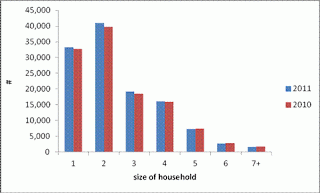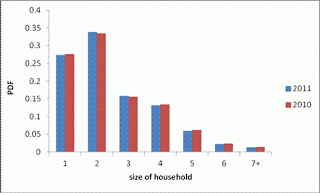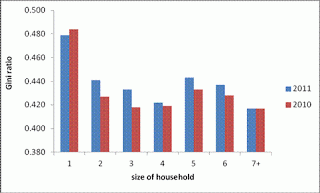

| Visitors Now: | |
| Total Visits: | |
| Total Stories: |

| Story Views | |
| Now: | |
| Last Hour: | |
| Last 24 Hours: | |
| Total: | |
The size of household and the rise in Gini ratio from 2010 to 2011
Sunday, September 16, 2012 22:55
% of readers think this story is Fact. Add your two cents.
Yesterday, I showed that the average size of household in the US has been decreasing since the start of measurements in 1967. This is the reason behind the decreasing average household income and increasing Gini ratio. The Census Bureau (CB) should not publish these figures without correction for the average household size. The reported values are definitely biased and used for political games. This is unacceptable for a nonpartisan statistical agency.
The CB does publish the size distribution of households and the mean household size. For 2011 and 2010, Figure 1 shows the number of households in the USA. It is worth noting that both numbers are obtained as a projection from the figures obtained during the CPS (around 75,000 households selected in a “scientific” way) with population controls taken from the 2010 census. The number of households is not a directly measured value! From Figure 1, one can observe that the number of one- , two-, and three-person households increased from 2010 to 2011. Obviously, smaller households should be characterized by lower incomes. Therefore, more low-income households should produce higher inequality raising the share of low-incomers.
However, the total number of households also grew from 2010 to 2011 and one needs relative values instead of absolute in order to estimate the input of household size. Figure 2 shows the probability distribution function for two distributions in Figure 1, i.e. the original distributions normalized to the associated total numbers. One can observe that the share of two and three-person households increased with the portion of one-person household slightly smaller in 2011.
The Census Bureau also publishes the average household sizes. In 2010, it was 2.58 per household and only 2.55 in 2011. (In my previous pos , I used the total household population, and the CB likely used the civilian population to estimate the size. ) The mean size fell by 1.2% with the Gini ratio increased from 0.47 to 0.477, i.e. by 1.4%. As we discussed before, the change in mean size should manifest itself in increasing Gini ratio. This is the reason for the step in the household Gini ratio as observed in 2011.
Figure 3 depicts two distributions of Gini ratio as a function of household size: for 2010 and 2011. These figures are borrowed from the CB. Except the one-person households, Gini ratio increased for all household sizes in 2011. Interestingly, the rise in Gini ratio in two groups with different average incomes does not necessary result in increasing Gini ratio for the joint group. The increasing inequality may be accompanied by decreasing difference between the average incomes and thus reduce the overall income dispersion.
Figure 1. The number of households (thousands) as a function of size. All households with seven and more people are gathered in one bin “7+”.
Figure 2. Probability distribution function for the distributions in Figure 1.
Figure 3. Gini ratio as a function of household size.
2012-09-16 22:45:51
Source: http://mechonomic.blogspot.com/2012/09/the-size-of-household-and-rise-in-gini.html
Source:





